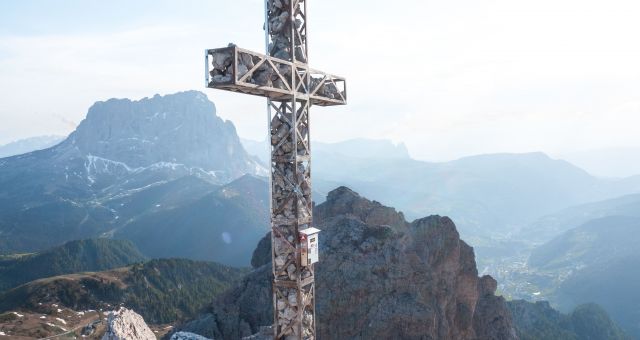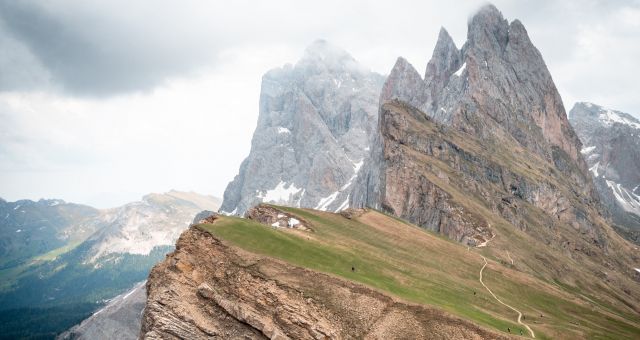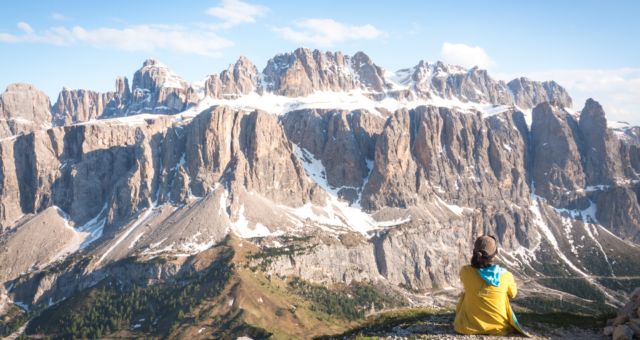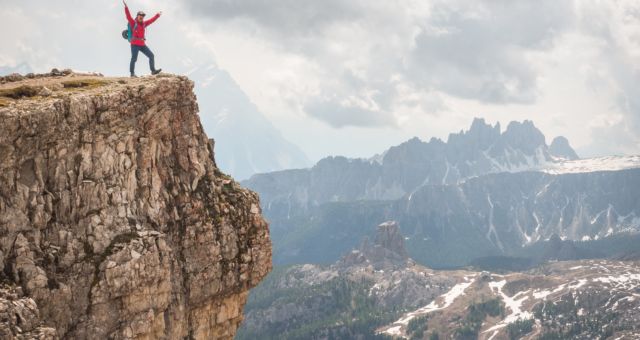The reason to visit the Dolomites can be summed up in one sentence: it’s the ultimate alpine playground for outdoor enthusiasts. Jack and I recently spent 3 weeks in the Dolomites and we loved it so much! It was one of the best trips we’ve ever taken together. The whole region is just one breath-taking panorama after another.
As far as an alpine playground goes, the Dolomites is also a highly accessible one. High above the alpine meadows and picturesque villages are pale spires and rockwalls, easily explored thanks to a network of well-signed hiking trails and cable cars. Within this network you’ll also find alpine huts (refuges or refugio) where lunch, drinks, and accommodations can be had.
You can spend days out there with just a daypack, hiking from one hut to another, without needing to return to civilization.
The Dolomites is the ultimate alpine playground
Hiking Vallesinella Waterfall in the Dolomiti Brenta. More information here
Canyoning Val di Ledro – credit: Visit Trentino
Adventure Activities in the Dolomites.
What can’t you do in the Dolomites? For outdoor lovers, endless possibilities for adventures exist. Here are some of our favorite adventure activities in the Dolomites:
Downhill Mountain Biking
Downhill mountain biking in the Dolomites is crazy fun. A combination of gondola and ski lift ferried us and our bikes up the mountain, and then all we had to do is point the bikes downward… and off we go.
I started on what the bike rental guy said was “suitable for kids” and I expected something as exciting as a stroll around a lake. But oh boy, I was wrong. So wrong.
There were banked turns, roots, drops (little ones, but still) on steep, narrow tracks. I felt like I was constantly just shy of completely losing out of control. I had a huge grin plastered on my face even as I was screaming after every successful turn and rise maneuvered. What a rush!
(They put kids on this trail?!!)
In Andalo, Dolomiti Paganella provided me with a rental bike and a lift pass first time around, but I had so much fun I went back for the second time on my own dime.
Mountain biking in the towns of Andalo, Dolomiti Paganella
Hiking for Days
The Dolomites offers anything from short hikes suitable for anyone to multi-day treks. Cable cars and ski lifts easily transport hikers to trailheads close to the peaks – skipping the drudgery of gaining elevation (I do like to earn my peaks, but while in Rome…) Clearly signed trails and a network of alpine huts make the Dolomites truly a trekker’s paradise.
Jack and I took every chance we got to explore the trails during our 3 weeks there. We loved the trails at Seceda, Val di Gardena, Sella Pass, Val di Fassa, and more! I’ll be sharing some of our favorite easy hikes in the Dolomites.
Related: Best Scenic Hikes in the Dolomites
Hiking near Tre Cime de Lavaredo
Via Ferrata
My love for via ferratas has been well documented, and I was so excited to be in the Dolomites.
There are hundreds of via ferrata routes of varying difficulties in the Dolomites region. The Dolomites is after all the birthplace of via ferratas! The “iron road” came about during WW1 as a way for troops to get across these formidable mountains.
You will of course need safety equipment: helmet, gloves, a harness, a via ferrata kit, and shoes with thick soles. Guided via ferratas can be arranged at any sport center, but if you’ve got some experience, you can simply rent the necessary gear and go at them yourself. Tourist information centers can provide you with the necessary maps.
If you’re visiting the Dolomites and have the head for heights, I highly recommend doing a via ferrata!
Here are some of the via ferratas we looked at:
- Via Ferrata Tridentina to Pisciadu starts at the bottom of the valley near Colfosco, and goes up next to a waterfall to Refugio Pisciadu. It’s one of the most popular via ferratas in Alta Badia region.
- Via Ferrata delle Aquile is located on Cima Roda della Paganella in Trentino. It provides extraordinary view across the Adige Valley and the Brenta Dolomites. You’ll need to take a cable car to the trail head.
- Via Ferrata Cesco Tomaselli, starts at the top of Lagazuoi Mountain that can be reached by a cable car. The most difficult stretch involves an overhanging traverse.
Via ferrata delle Aquile, Dolomiti Brenta – credit: Visit Trentino
Stunning Sceneries for Roadtrip Lovers
If you love roadtrips, you should definitely visit the Dolomites.
The Dolomites is known for its exhilarating drives through the mountain passes, with its many sharp curves and switchbacks. No wonder we often found ourselves sharing the road with numerous cyclists, motorcyclists, and sports car aficianados. These road enthusiasts flock to the Dolomites for the thrill of driving its roads, and of course – the stunning scenery.
Before my visit, I’ve seen photos of the Dolomites. But after seeing the real thing… those photos don’t do justice.
Some of the stunning mountain passes of the Dolomites we drove through are: Passo Sella, Passo Giau, and Passo Gardena.
Passo Gardena
Learning about WW1
One of the frontlines between Italy and Austria during WW1 is located in the Dolomites. In Lagazuoi and Cinque Torri, for example, you can explore the remains of tunnels, bunkers, and trenches – created by both Italian and Austrian troops in their attempt to gain control of the summit and the pass. The whole area has been turned into an open-air museum.
So many people have lost their lives in the most beautiful settings. It was a sobering thought.
Related: Hiking the WW1 Tunnels of Lagazuoi
Lagazuoi, the frontline during WW1.
Rock Climbing
If you’re a rock climber, the Dolomites offers endless possibilities at any grade and length. I mean, just look at all of those peaks and spires. There’s a reason why Adam Ondra, one of the world’s most famous rock climber, makes his summer home in the region.
Jack and I only had time to climb 2 towers: one of the Sella Towers and Cima Grande (one of the Tre Cime de Lavaredo). Our personal opinion (based on very limited experience): do it for the view, not so much for the superb rock, and be really good at route finding and runouts. I had my eyes on climbing Campanile Basso in Dolomite Brenta – it’s such as a striking formation – unfortunately I didn’t have good weather nor time *sad face*.
Climbing the Sella Tower
Tre Cime de Lavaredo. We climbed the middle tower. No pics from the climb since it ended up being kind of a shitshow. Oh well…
Paragliding
I went paragliding at Molveno with I Fly Tandem Molveno and loved it so much! It was only my second time paragliding, but I know it won’t be my last.
The view of Molveno Lake was spectacular. My guide happened to be a paragliding world champion so I felt very safe. Especially when he started doing tricks on the air. I don’t remember the last time I screamed-slash-laughed in such a hysterical manner. What. A. Rush!
Paragliding over Lake Molveno
Eating Delicious Mountain Food
Ok, this is not adventurous BUT it’s impossible to talk about the Dolomites without mentioning the food. Some of the best ones we had didn’t come from some fancy restaurants, but in alpine huts high up in the mountains. Reachable only after a hike or taking a cable car.
Typical mountain food in the Dolomites
The desserts at Rifugio La Roda
The food in the Dolomites can be described as stick-to-your-bones. Some of local specialties we ate include canederli (savory dumplings with bread crumb, served in broth), polenta with wild mushroom, apple strudel, and of course tons and tons of pizza and pasta.
This being Italy, I didn’t have any bad meal. However, a couple of meals stood out as being simply so much better than the rest:
- Rifugio La Roda. One of the best meals I had in the Dolomites. With an expansive view of Dolomiti di Brenta, enjoy the polenta soup, the tagliatelle, and make sure to save room for desserts (important!). Everything was made from scratch, using ingredients grown locally.
- Rifugio Casinei. A 30 minute walk from the car park of Valesinella, this rifugio is a perfect stop when exploring Dolomiti di Brenta. The gregarious owners and the delicious homemade local specialties are the reasons that even locals would make the journey to eat here.
- Pizzeria Ristorante El Bronsin in Cortina d’Ampezzo. Beautifully prepared pasta and pizza, and reasonably priced too especially for Cortina. Our group went there twice for dinner and we loved everything we ordered!
When to Visit:The Dolomites is Not Just A Summer Destination
Summer (June – October) is ideal for high altitude exploration although depending on snow fall, you might still encounter some snow patches early in the summer. Refuges (alpine huts) start operating from late June through late September. August is the busiest season just like anywhere in Europe which is why you’ll never find me anywhere in Europe in August.
Fall (September – October) offers crisp weather, solitude, and better chance for clear, cloudless skies as well as wildlife encounter. However, towards the end of October most accommodations and restaurants might be closed for the season.
Winter is all about snow sports: cross country skiing, downhill skiing, and dog sledding. I would LOVE to come back in winter.
On the way to Rifugio Brentei, Dolomiti Brenta. Hiking the Dolomites in early summer means snow encounter is more than a possibility.
Getting Around the Dolomites
Local transport is excellent. Combination of trains and buses means getting a car is optional. Many trailheads are accessible by public transport. Keep in mind that each province runs its own bus network, which could lead to confusion as foreign visitors might not know where the boundaries are (or even which province they’re currently in). Be aware that some buses don’t go into full swing until high season kicks in. So always check latest the schedule.
The main bus companies in the Dolomites are:
SAD (Alto Adige or South Tyrol)
Trentino Transporti (Trentinto Province)
Dolomiti Bus (Veneto)
Trenitalia (for trains).
Note: South Tyrol is called Südtirol in German and Alto Adige in Italian. I mentioned this here because it took me a long time to figure this out.
Having said that, renting a car makes it easier to see more of the Dolomites. Jack and I rented a car from Europcar in Trento because with all of our climbing gear, it was just easier. Plus having our own transport allowed us to get to trailheads early before the crowds.
Exploring the Towns of Dolomites
Dolomite doesn’t just offer natural beauty. All throughout the Dolomites can be found thriving towns that offer cultural experience, food and wine tours, and historical monuments in beautiful settings. Plus, a few castles to explore here and there.
The towns in the Dolomites offer more than just respites from the weather. A town like Trento has enough attractions to keep anyone busy for 2-3 days. It has great museums, a historical castle, and a colorful, oh-so-pretty old town. I know that if I’m traveling with my parents, they would appreciate taking a break from all the outdoor activities in bigger cities such Trento.
The town of Trento.
Where to Stay in the Dolomites
Even though the Dolomites is compact, it can take some time to go from one town to the other because of its geography: mountain ranges, valleys, and rivers that get in the way of straight-line travel.
If you’re staying in the Dolomites for awhile (lucky you!), I recommend staying in different regions throughout your stay. When exploring Dolomiti Brenta: Madonna di Campiglio makes the most sense. Tre Cime de Lavaredo, arguably the Dolomites’ most famous landmark, can be easily visited from Cortina d’Ampezzo. While the town of Ortisei is close to Seceda Mountains and Passo Gardena.
What We Did
Jack and I divided our time in the Dolomites between 3 towns: Trento (Trentino Province), Colfosco (Alta Badia Province, near Selva Pass/Paso di Selva), and Cortina d’Ampezzo (Veneto Province).
Where to stay in Trento: I recommend staying in one of the many affordable apartments in the old part of Trento. Lagom Apartments is one of such. This 3 bedroom apartment is only $110/night for 2 people. While Vetro is a luxury B&B – $95/night for double occupancy.
Where to stay in Colfosco: We stayed in Residence Mirabelle. It’s a family-run garni that includes breakfast. The rooms are large and modern. $90/night.
Where to Stay in Cortina d’Ampezzo, we shared a 3 bedroom apartment, Villa Casanova, with another couple. One of the more affordable apartments in this expensive resort town. Slightly outdated furnishing, but we loved its location. It’s within walking distance of the main street.
Where to Stay in Madonna di Campiglio (where I stayed before Jack arrived), I recommend Chalet del Sogno – huge, comfortable bed, a sauna, and 5 star service.
The town of Cortina d’Ampezzo
Dolomites Essentials
What to Pack
– Well broken-in hiking shoes
– Daypack (big enough for snack/drink for a day, along with extra layers). I always take at least one packable daypack with me on my trips. It packs to nothing and it’s so handy. Something like this.
– Hat
– Sun glasses
– Sunscreen (mineral-based is the best)
– Pack layers, including rain-proof layers. Even in the middle of the summer.
Tips for Visiting the Dolomites
- Gas stations often will not take American credit cards. It seems to be hit and miss. So be sure to always carry Euros.
- Watch out for shoulder season. Most towns shut down from October-December and March-April, that means restaurants and accommodations will be hard to find during this time.
- Having Internet while going on roadtrips is very useful. You can get local SIM card, but since I have Google Fi, I get cellular date on my phone in over 170 countries (try it out: use this code for $20 credit).
Getting to the Dolomites
Milan or Venice are probably going to be the best cities to start your adventures in the Dolomites. From Milan or Venice, you can take a train to Trento (transfer in Verona). Trento is on the southern edge of the Dolomites. From Trento, you can take a train or bus to other cities in the Dolomites region. Or do what we did and rent a car from Trento. It’s also possible to rent a car in Venice.
The Dolomites is at the border between Italy and Austria. It’s about a 6 hr drive from Vienna.
Dolomite Itinerary
Check out this post for a sample itinerary for a 3 week roadtrip in the Dolomites.
Some of the activities here were hosted by Visit Trentino: mountain biking, paragliding, my stay at Chalet del Sogno, as well as some meals. The rest was at my own expense.






Questions and Comments
Comments are disabled. If you have any questions about the post, you can DM me on Instagram: @jacknjilltravel.